Site menu:
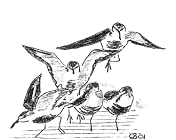
November 2010 Newsletter
Lapland Bunting Influx.
October Bird News.
Forthcoming Events.
Latest Newsletter.
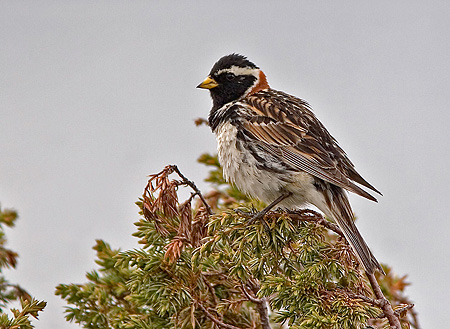
October saw an unusually high number of Lapland Bunting reports for the Dee Estuary, this article puts those records into a national perspective and explains where the birds probably came from.
The Lapland Bunting (otherwise known as Lapland Longspur) is a relatively common bird across our planet's northern hemisphere, it is a circumpolar breeder and can occur in large flocks in it's wintering grounds, particularly in the USA. However, because of the UK's location on the western edge of Europe it is something of a no go area for this species with north-European breeding birds mainly heading south east for winter, and Greenland and east Canadian birds mainly heading south west. Usually there are just a few birds reported on migration in autumn on both the west and east coasts of the UK, with a few also over wintering, mainly on the east coast. Occasionally, though, due probably to unusual weather patterns during migration, we get a large influx of these birds, and 2010 is one of those rare influx years.
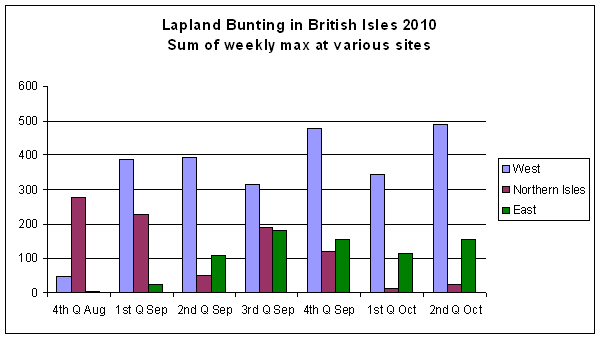
This graph is not meant to represent the total number of birds present,
but by summing the weekly max at certain key sites it gives a good idea of
how the birds were distributed week by week, split between (a) the west of
the British Isles, including the whole of Ireland and Wales, plus the west
coast of Scotland and England, (b) the Northern Isles (Fair Isle, Orkney
and Shetland) and (c) the east coast of Scotland and England.
 Apart from a handful of early single birds the migration
started in earnest on Aug 28th with several small flocks reported in the
south-west of Ireland and a large flock of 58 on the Orkneys, plus four on
the Great Orme, just up the coast from the Dee Estuary. By Sep 1st it was
obvious that really big numbers were involved with a record count of 184 on
Fair Isle, and over the next couple of days large numbers were in the Outer
Hebrides with three figure flocks then reported here right through into
Oct. As numbers dropped in the Northern Isles through Sep several small
flocks started appearing along the east coast, including a flock of 56 in Lincolnshire
on
Sep 28th. Closer to home a large flock built up at Cemlyn Bay, Anglesey, with 60 here in
early Oct. (photo of Lapland Bunting on Hilbre, Oct 17th, © Steve
Williams).
Apart from a handful of early single birds the migration
started in earnest on Aug 28th with several small flocks reported in the
south-west of Ireland and a large flock of 58 on the Orkneys, plus four on
the Great Orme, just up the coast from the Dee Estuary. By Sep 1st it was
obvious that really big numbers were involved with a record count of 184 on
Fair Isle, and over the next couple of days large numbers were in the Outer
Hebrides with three figure flocks then reported here right through into
Oct. As numbers dropped in the Northern Isles through Sep several small
flocks started appearing along the east coast, including a flock of 56 in Lincolnshire
on
Sep 28th. Closer to home a large flock built up at Cemlyn Bay, Anglesey, with 60 here in
early Oct. (photo of Lapland Bunting on Hilbre, Oct 17th, © Steve
Williams).
Where did these birds come from? Surprisingly little is known for sure as to the origin of the usual small numbers of passage and over wintering birds in this country. But there is a lot of circumstantial evidence that the birds we see on migration along the west coast in autumn come from the Greenland population, whereas the over wintering birds, mainly recorded on the east coast, are probably north European breeding birds. The pattern of movement this year as described above - with many birds arriving first on the west coast, together with reports of unusually large numbers in Iceland, strongly suggest that these birds came from Greenland. Apparently there was an intense low pressure in the area in late August which meant many birds headed south-east, rather than the normal south-west. This species is supposedly split into races, and the American race is reported as being bigger than the European race, but in practice it would seem that there is so much overlap that it is virtually impossible to distinguish the two.
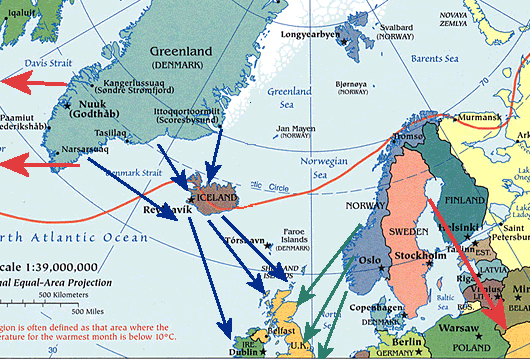
The red-orange arrows show the main migration routes, with the blue and green arrows
showing the route of the Greenland and north European birds which come to the British
Isles, most years this involves just a few birds.
2010 has also seen an unusually high number of records
from the shores of the Dee Estuary, albeit in tiny numbers compared to some
sites but undoubtedly part of the same influx. The usual pattern of records
here is of an average of about one a year, typically of one or two birds either
on autumn or spring passage on Hilbre, or over wintering on Burton Marsh.
2010 started well with a male in full breeding plumage at Red Rocks on May
22nd, but the autumn records started with two at the Point of Ayr on Sep
23rd.
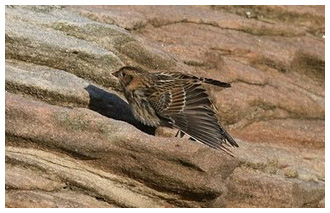 There were a further 11 records, the majority coming from Hilbre, six
which were observed coming off the sea at Red Rocks on Oct 11th was the
highest count. At least 22 different birds were counted, perhaps as many as
24 in total. It was 1990 when we had a similar influx here with Oct records
including 13 on Burton Marsh and several records of singles from Hilbre and
Red Rocks, but sightings continued until the end of the year including a
remarkable flock of 20 on Nov 14th on Burton Marsh - so if 2010 follows the
same pattern there must be a
very good chance that we will get some more birds here in the next couple
of months. (photo of Lapland Bunting on Hilbre, Oct 17th, © Steve
Williams).
There were a further 11 records, the majority coming from Hilbre, six
which were observed coming off the sea at Red Rocks on Oct 11th was the
highest count. At least 22 different birds were counted, perhaps as many as
24 in total. It was 1990 when we had a similar influx here with Oct records
including 13 on Burton Marsh and several records of singles from Hilbre and
Red Rocks, but sightings continued until the end of the year including a
remarkable flock of 20 on Nov 14th on Burton Marsh - so if 2010 follows the
same pattern there must be a
very good chance that we will get some more birds here in the next couple
of months. (photo of Lapland Bunting on Hilbre, Oct 17th, © Steve
Williams).
Richard Smith
Sources of information for this article:
1.
Birdguides - www.birdguides.com, an
invaluable source of information for the Bar Chart above.
2. Birds of the Western Palearctic (BWPi - interactive edition).
3. Cheshire and Wirral Bird Reports - 1964 to 2009.
4. Latest Sightings on
www.deeestuary.co.uk and all the birders who send me their records.
5. Hilbre Bird Observatory -
http://www.hilbrebirdobs.blogspot.com/.
6. Various threads on www.birdforum.net.
7.
http://birdingfrontiers.com/2010/09/01/lapland-bunting/, for
information on trying to distinguish the races of Lapland Bunting.
8. The Cheshire & Wirral Atlas by David Norman, 2008.
9. The Migration Atlas, BTO.
10. The Lapland Longspur entry on
www.wikepedia.com.
Map kindly provided by University of Texas Libraries (arrows added by the author).
October Bird News
The weather was never quite right for a large visible migration, but what we didn't get in quantity we made up for in quality - Lapland Buntings in particular (see above article). We also had four Ring Ouzels, three Firecrests, a Barred Warbler, one Grey Grey Shrike, 30+ Crossbills, a Siberian Chiffchaff, four Twite and two Waxwings. The first Snow Bunting of the winter turned up on the sea wall at Meols on the 30th.

After a very good September for marsh terns at Inner Marsh Farm, with several Black and a Whiskered Tern present, it was a big surprise that yet another one turned up this month; a White-winged Black Tern form 14th to 18th. One Curlew Sandpiper was present at Inner Marsh Farm for most of the month with two present on two dates, and there were also good numbers of Little Stints including seven on the 2nd and eight on the 6th. Four Little Stints were at Connah's Quay on the 9th where there had been a Long-billed Dowitcher the previous day. There were quite a few Greenshank passing through including 11 at Heswall on the 18th.
There were two very high counts of Great Crested Grebes off Dove Point, Meols, with 546 on the 11th and 604 on the 25th, a record count for Cheshire and Wirral and it is likely to be in the top four highest counts in the country for 2010/11 WeBS. Two Slavonian Grebes were off Red Rocks on 28th. 15 Red-throated Divers were off Hilbre on the 24th, max count of Brent Geese was 42.
Two Marsh Harriers were on Heswall Marsh during the high tide on the 8th and there were several reports of single birds. Hen Harriers had reached four by the end of the month at the Parkgate roost. Three Short-eared Owls were on Burton Marsh early in the month. There were three reports of Red Kites, one near Mostyn Dock on the 11th, one over Holywell on the 14th and another over Frankby on the 27th.
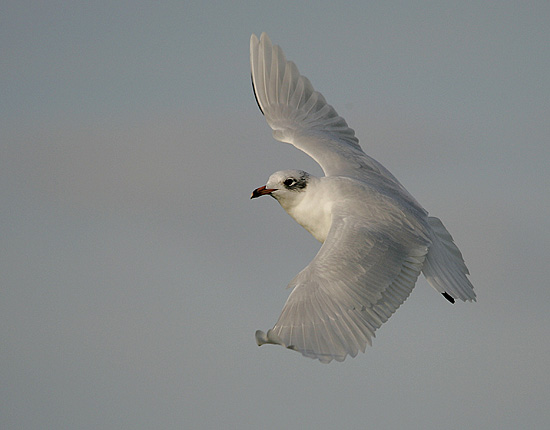
Richard Smith.
What to expect in November
As I write this at the end of October there are a lot of Waxwings in the country, particularly Scotland, so hopefully we will see some flocks down here.
Wader numbers should increase sharply this month, particularly Knot and Dunlin, with Hoylake shore the best place to see large roosting flocks, but also try Point of Ayr or West Kirby, and Thurstaston or Leasowe at low tide. Brent Geese numbers should reach over 100 by the month-end, they can be seen at low tide at Hilbre or off Little Eye at high tide, sometimes they come right into West Kirby shore.
Given the Lapland Bunting influx described above we would expect to see more of these, and also one or two Snow Buntings. Last year we had a long staying Shore Lark between Gronant and Point of Ayr.
There aren't any really big tides this month but the tides should be high enough on the 6th, 7th and 8th to bring the sea over the marsh at Riverbank Road, Heswall, and should result in some good views of Short-eared Owls, Hen Harriers, Peregrines and the usual masses of waders and wildfowl.

Although looking like a dusk shot it was actually taken mid-morning with hazy sunlight reflected
off the water and the camera on 'auto'! © Richard Smith.
Forthcoming Events
November Highest Spring Tides (Liverpool)
Also see
Tides page.
6th November, 10.37hrs (GMT), 9.6m.
7th November, 11.19hrs (GMT), 9.7m.
8th November, 12.00hrs (GMT), 9.6m.
Forthcoming Events
Organised by the
Wirral Ranger Service ,
Flintshire Countryside Service and/or the RSPB:
All these events and walks have bird interest, even those not advertised
specifically for birdwatching. No need to book for these events unless
specified - please check below.
Saturday 6th November - 9:30am start, Birdwatch at King's Gap, Hoylake.
Come along to Hoylake Foreshore and join members of the Coastal Rangers,
the Dee Estuary Voluntary Wardens and the RSPB and see what birds can be
seen feeding on the outgoing tide. This event is suitable for all the
family to enjoy. All children under 8 must be accompanied by an adult.
Dress warmly and bring binoculars if you have them.
Meet at King’s Gap on Hoylake Promenade.
For further enquiries call: 0151 678 5488 or 0151 336 7681.
Wednesday 10th November - 10am start, Estuary Watch: The
Thurstaston Circle.
A walk along the shore from Thurstaston to Lower Heswall will give us views
of many thousands of estuary birds before we return to the Visitor Centre
via the Wirral Way. Along the path we will look for winter thrushes and
scan the farmland for more bird activity.
Please bring binoculars & warm waterproofs. No need to book.
Meet at Wirral Country Park Visitor Centre, Thurstaston.
For further enquiries ring 0151 648 4371.
Saturday 27th November - 12.30pm start, RSPB Burton Mere Walk.
This is for anybody wanting a free guided walk around Burton Mere and
"Inner Marsh Farm 2" to find out all about the reserve extension and
development.
Booking is essential so phone 0151 336 7681 to guarantee your place or to
get further details.
Sunday 28th November - 3pm start, Raptor Watch at
Parkgate Old Baths.
The RSPB Dee Estuary Nature Reserve is a vital wintering grounds for many
birds of prey – Discover these impressive birds in their wild habitat,
hunting before roosting on the saltmarsh. We can see up to 7 species of
birds of prey and 2 species of owl - so come along to find out more these
impressive hunters. Remember to bring your binoculars and dress
appropriately for the weather.
For further enquiries call: 0151 336 7681.
Friday 3rd December, Hilbre Low Tide Walk.
Join the Rangers and the RSPB Wardens for a guided wildlife walk over the
sands to the Hilbre Island.
The walk across the sands and mud should produce a mix a waders whilst the
stay on the island is a good chance to get great views of the wintering
population of Brent Geese.
Wrap up warm and bring a packed lunch. Wellies and binoculars recommended
Booking essential, with a £2 charge.
Phone 0151 648 4371 to book a place.
Wednesday 8th December, 9.30am start, Estuary Watch:
Riverbank Road for Raptors
Join the Rangers & WCP Recording Group at Riverbank Road car park in Lower
Heswall for the second in a winter long series of bird watching events on
the internationally important Dee Estuary. As the mudflats & marsh floods
we hope to see many waders, ducks & raptors.
Please bring binoculars & warm waterproofs. No need to book.
Meet at Riverbank Road Car Park, Lower Heswall.
For further enquiries ring 0151 648 4371.
Saturday 18th December - 12.30pm start, RSPB Burton Mere Walk.
This is for anybody wanting a free guided walk around Burton Mere and
"Inner Marsh Farm 2" to find out all about the reserve extension and
development.
Booking is essential so phone 0151 336 7681 to guarantee your place or to
get further details.
Sunday 19th December - 2.30pm start, Raptor Watch at
Parkgate Old Baths.
The RSPB Dee Estuary Nature Reserve is a vital wintering grounds for many
birds of prey – Discover these impressive birds in their wild habitat,
hunting before roosting on the saltmarsh. We can see up to 7 species of
birds of prey and 2 species of owl - so come along to find out more these
impressive hunters. Remember to bring your binoculars and dress
appropriately for the weather.
For further enquiries call: 0151 336 7681.
Saturday 15th January - 12.30pm start, RSPB Burton Mere Walk.
This is for anybody wanting a free guided walk around Burton Mere and
"Inner Marsh Farm 2" to find out all about the reserve extension and
development.
Booking is essential so phone 0151 336 7681 to guarantee your place or to
get further details.
|
 |
The blank (UK) Birding Webring is a collection of quality birding web sites that are based in the United Kingdom. Visit the webring homepage for more information, or A complete list of all the sites in the webring is available by clicking here. previous site in ring : random site in ring : next site in ring |